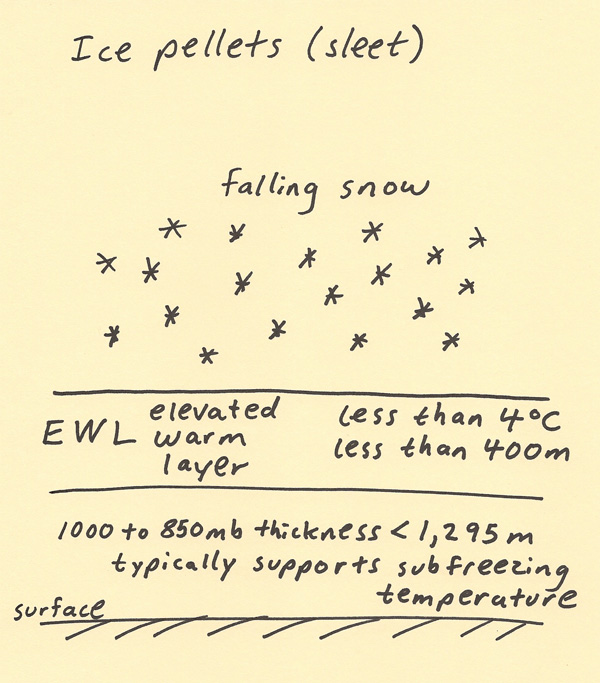
Sleet (also called ice pellets) is snow that partially melts and then freezes into a little ball of ice once they reach the ground surface. Sleet sometimes occurs in the transition from rain to snow or vice versa. Sleet indicates there is a layer aloft that is too warm to allow snow to reach the ground but there is another layer also below freezing that causes the partially melted snow to refreeze. Two areas of study for the vertical temperature profile are the EWL (Elevated Warm Layer) and the 1000 to 850 mb thickness. The EWL is a layer of above freezing air aloft. The process is shown in the diagram below. Snow falls from aloft and into the EWL. The snow partially melts while falling through the EWL. In order for the snow to partially melt (and not fully melt) the EWL needs to be less than a max temperature of 4 C and the vertical distance of the layer needs to be less than 400 m. If the EWL is very shallow or only a little above freezing, then the snow will not melt much and what could end up falling is a sleety snow or a wet snow. The EWL needs to almost melt the snow in order for sleet to occur. If the snow completely melts then it is more likely that the rain will supercool while falling through the subfreezing layer closer to the surface instead of freezing to sleet. Supercooled rain can produce freezing rain when the ground temperature is at or below freezing. After the snow partially melts into what appears as rain aloft (but with an embedded ice nuclei left), then the ice nuclei represents a nuclei that water can freeze on when the partially melted snow falls into a subfreezing layer. The 1000 to 850 mb thickness is used to determine how likely the partially melted snow will refreeze into sleet (keep in mind location needs to be less than 1000 feet elevation in order to use 1000 to 850 mb thickness). A 1000 to 850 mb thickness of less than 1,295 m typically supports subfreezing temperatures. Thus, EWL and 1000 to 850 thickness information can be used to assess the likelihood of the precipitation type being sleet.  |